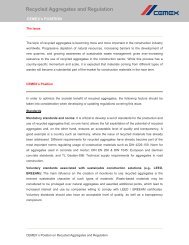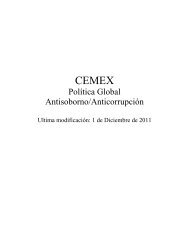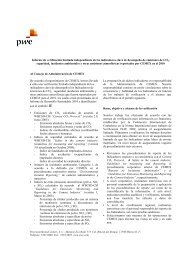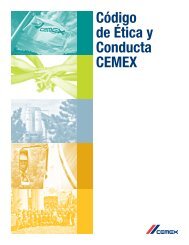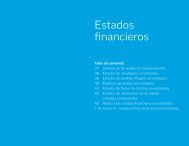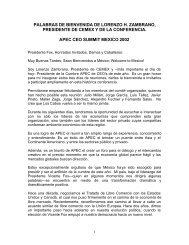building a STRONGER foundation - Cemex
building a STRONGER foundation - Cemex
building a STRONGER foundation - Cemex
Create successful ePaper yourself
Turn your PDF publications into a flip-book with our unique Google optimized e-Paper software.
CEMEX Venezuela<br />
As of and for the periods ended December 31, 2007 and July 31, 2008, measured in Pesos, our Venezuelan operations accounted<br />
for approximately 2.9% and 3.0% of our consolidated revenues, respectively, and 2.1% at the end of both periods of our consolidated<br />
total assets. In the event our affiliates receive compensation as a result of proceedings they have initiated against Venezuela for the<br />
expropriation of their investment in CEMEX Venezuela, it is expected that the award of such relief will enable us to reduce<br />
consolidated debt and/or to expand total installed capacity. Accordingly, we believe that the expropriation of our affiliates’ investment<br />
in CEMEX Venezuela will not have a material impact on our consolidated financial position, liquidity or results of operations. At the<br />
present time, however, it is not possible to predict the timing or amount of any award of restitution and/or compensation, the extent to<br />
which any order of restitution can be enforced, or the extent to which any monetary relief can be collected following an award. Until<br />
restitution and/or compensation is received, we will be negatively affected, although we do not expect such negative effect to be<br />
significant in light of our overall consolidated financial position.<br />
We consolidated the income statement of CEMEX Venezuela in our results of operations for the seven-month period ended<br />
July 31, 2008. For balance sheet purposes, as of December 31, 2008, our investment in Venezuela was presented within “Other<br />
investments and non current accounts receivable.” As of December 31, 2009 and 2010, the net book value of our investment in<br />
Venezuela was approximately Ps6,147 million and Ps6,203 million, respectively, corresponding to the interest of our affiliates of<br />
approximately 75.7%.<br />
See note 11A to our consolidated financial statements included elsewhere in this annual report.<br />
See “Item 4 — Information on the Company — Regulatory Matters and Legal Proceedings — Other Legal Proceedings —<br />
Expropriation of CEMEX Venezuela and ICSID Arbitration.”<br />
Qualitative and Quantitative Market Disclosure<br />
Our Derivative Financial Instruments<br />
For the year ended December 31, 2008, 2009 and 2010, we had a net loss from financial instruments of approximately Ps15,172<br />
million, Ps2,127 million and Ps956 million, respectively.<br />
Since the beginning of 2009, with the exception of our capped call transaction entered into in March 2010, we have been<br />
reducing the aggregate notional amount of our derivatives, thereby reducing the risk of cash margin calls. This initiative has included<br />
closing substantially all notional amounts of derivative instruments related to our debt (currency and interest rate derivatives) and the<br />
settlement of our inactive derivative financial instruments (see note 12C to our consolidated financial statements included elsewhere in<br />
this annual report), which we finalized during April 2009. The Financing Agreement significantly restricts our ability to enter into<br />
derivative transactions.<br />
We use derivative financial instruments in order to change the risk profile associated with changes in interest rates and foreign<br />
exchange rates of debt agreements, as a vehicle to reduce financing costs, as an alternative source of financing, and as hedges of:<br />
(i) highly probable forecasted transactions, (ii) our net assets in foreign subsidiaries and (iii) future exercises of options under our<br />
executive stock option programs. Before entering into any transaction, we evaluate, by reviewing credit ratings and our business<br />
relationship according to our policies, the creditworthiness of the financial institutions and corporations that are prospective<br />
counterparties to our derivative financial instruments. We select our counterparties to the extent we believe that they have the financial<br />
capacity to meet their obligations in relation to these instruments. Under current financial conditions and volatility, we can not assure<br />
that risk of non-compliance with the obligations agreed to with such counterparties is minimal.<br />
The fair value of derivative financial instruments is based on estimated settlement costs or quoted market prices and supported<br />
by confirmations of these values received from the counterparties to these financial instruments. The notional amounts of derivative<br />
financial instrument agreements are used to measure interest to be paid or received and do not represent the amount of exposure to<br />
credit loss.<br />
122<br />
At December 31, 2009 At December 31, 2010<br />
Notional<br />
amount<br />
Estimated<br />
fair value<br />
Notional<br />
amount<br />
(in millions of Dollars)<br />
Estimated<br />
fair value Maturity Date<br />
Equity forward contracts................................................................. 54 54 53 15 October 2011<br />
Other forward contracts .................................................................. 55 1 16 1 October 2011<br />
Other Equity Derivatives ................................................................ 860 (79) 1,575 (71) April 2015<br />
Derivatives related to energy .......................................................... 202 27 196 35 September 2022



